The Adventures of André and Wally B. (1984)
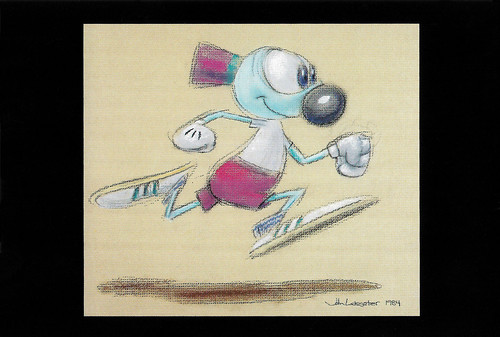
American postcard by Disney Enterprises / Pixar Animation Studios, 2005. Image: Pixar Animation Studios. Concept art work by John Lasseter for The Adventures of André and Wally B. (Alvy Ray Smith, 1984). From 'The Art of Pixar: 100 Collectible Postcards, published by Chronicle Books.
The short The Adventures of André and Wally B. (Alvy Ray Smith, 1984) or André and Wally B. is a pioneering 3D animation from the people who would go on to become Pixar. A brainless android, André, wakes up to be taunted by a large bee, Wally B. The Adventures of André and Wally B. is generally considered to be the first 3D animation with a plot. Needless to say, it's an important movie.
The Adventures of André and Wally B. is the CG animation equivalent of the first flight of the Wright Brothers, which lasted only 12 seconds). Much like that famous first flight in 1903, this 1984 film paved the way for all that has followed. It is not the first CG animation ever made, but it is the first to feature a plot, characterisation and expression, motion blur, and deformations (e.g. stretching, squashing). When it was demonstrated at the 1984 SIGGRAPH there was a crowd response bordering on hysteria, as nothing even close to this had ever been done before.

American postcard by Disney Enterprises / Pixar Animation Studios, 2005. Image: Pixar Animation Studios. Film image for The Adventures of André and Wally B. (Alvy Ray Smith, 1984). From 'The Art of Pixar: 100 Collectible Postcards, published by Chronicle Books.
Luxo Jr. (1986)

American postcard by Disney Enterprises / Pixar Animation Studios, 2005. Image: Pixar Animation Studios. Concept art by John Lasseter for Luxo Jr. (John Lasseter, 1986). From 'The Art of Pixar: 100 Collectible Postcards, published by Chronicle Books.
Luxo Jr. (John Lasseter, 1986) about two living lamps, was the first computer-animated short that was ever nominated for an Academy Award and was the start of the dazzling success of the Pixar studio. Luxo Jr. is now officially the mascot of Pixar, and the small hopping lamp now acts as the lowercase "i" in Pixar's logo. In 1986 Pixar Animation Studios produced the short Luxo Jr. (John Lasseter, 1986). It was Pixar's first film since founders Ed Catmull and John Lasseter had left ILM's computer division and founded Pixar as an independent film studio.
The clip (it is only 2 minutes and 18 seconds long) demonstrated what Pixar was capable of. Lasseter applied the classic animation principles popularised by Disney to convey the lamps' emotions. The animation is vibrant and beautiful and done with character. The computer-animated short sent shock waves throughout the industry. At the time most animators were fearful of the computer. Luxo Jr. (1986) made them appreciate that it was just another tool. The nomination for the Oscar for the best short animated film was the start of the meteoric rise of Pixar Studios.
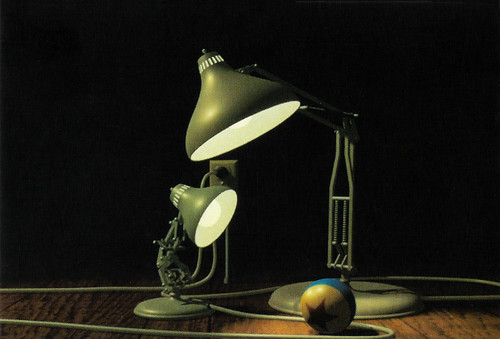
American postcard by Disney Enterprises / Pixar Animation Studios, 2005. Image: Pixar Animation Studios. Film image of Luxo Jr. (John Lasseter, 1986). From 'The Art of Pixar: 100 Collectible Postcards, published by Chronicle Books.
Red's Dream (1987)
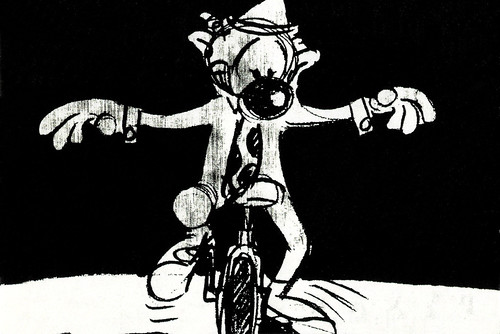
American postcard by Disney Enterprises / Pixar Animation Studios, 2005. Image: Pixar Animation Studios. Storyboard by John Lasseter for Red's Dream (John Lasseter, 1987). From 'The Art of Pixar: 100 Collectible Postcards, published by Chronicle Books.
The short Red's Dream (John Lasseter, 1987) runs for four minutes and stars Red, a unicycle. With a sale tag hanging from his seat, propped up in the corner of a bicycle store on a rainy night, Red dreams about a better place. Red's Dream was Pixar's second computer-animated short following Luxo Jr. (1986), also directed by Lasseter. It is one of Pixar's lesser-known efforts.
John Lasseter and William Reeves separately wrote a script for a film that could be made with Pixar Image Computer. Lasseter's script revolved around a clown and his unicycle, and Reeves' script was about a city during a nighttime rainstorm. Eben Ostby wanted to try drawing a bicycle on the computer for the next film. In the end, the three combined their ideas into Red's Dream. It was the first Pixar film to feature a human being: the clown Lumpy. Furthermore, this is the only film made on the Pixar Image Computer and the only one that was never released together with one of the bigger Pixar films.

American postcard by Disney Enterprises / Pixar Animation Studios, 2005. Image: Pixar Animation Studios. Film image of Red's Dream (John Lasseter, 1987). From 'The Art of Pixar: 100 Collectible Postcards, published by Chronicle Books.
Tin Toy (1988)
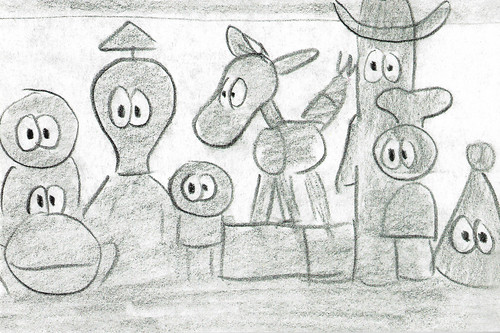
American postcard by Disney Enterprises / Pixar Animation Studios, 2005. Image: Pixar Animation Studios. Storyboard by John Lasseter for Tin Toy (John Lasseter, 1988). From 'The Art of Pixar: 100 Collectible Postcards, published by Chronicle Books.
In the short Tin Toy (John Lasseter, 1988), a tin one-man-band toy tries to escape a destructive baby. The Pixar production is considered to be a prequel to Toy Story. In 1989, it won the Oscar for Best Animated Short, the first fully-CG film to do so. At the end of 1988, Pixar employees in Stillwater Cove developed new software, entirely focused on the work of animators. To show the possibilities of this programme, it was decided to make a new animated film. Producer William Reeves came up with the idea of making a film about a baby, after the birth of his daughter Julia. The idea for the toy man came from John Lasseter, a toy collector who had visited the Tin Toy Museum in Japan in 1987.
Tin Toy was first demonstrated at SIGGRAPH, and received a standing ovation from the audience. In 1989, Tin Toy won the Academy Award for Best Short Animation and the WAC Winner for Computer-Assisted Animation. Years later, John Lasseter took up the idea of the story for a full-length film after Pixar was hired by Disney. The story was re-worked until it became what is known as Toy Story (John Lasseter, 1995). Tinny was originally supposed to be in the place of Buzz Lightyear when Buzz was going to be the new toy in Toy Story. But Tinny was scrapped after everyone thought that an old fashion tin toy like Tinny was would not be a kids' new favorite toy. The Tin Toy makes a cameo in Toy Story 4 (2019) and Bo Peep addresses him as Tinny.
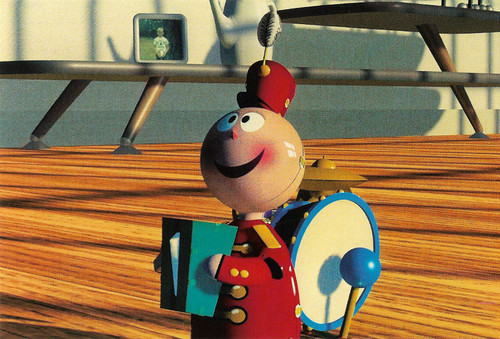
American postcard by Disney Enterprises / Pixar Animation Studios, 2005. Image: Pixar Animation Studios. Film image for Tin Toy (John Lasseter, 1988). From 'The Art of Pixar: 100 Collectible Postcards, published by Chronicle Books.
Knick Knack (1989)
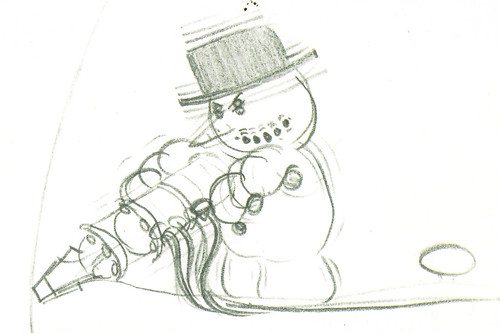
American postcard by Disney Enterprises / Pixar Animation Studios, 2005. Image: Pixar Animation Studios. Storyboard by John Lasseter for Knick Knack (John Lasseter, 1989). From 'The Art of Pixar: 100 Collectible Postcards, published by Chronicle Books.
In the Pixar short Knick Knack (John Lasseter, 1989), a snow globe snowman wants to join the other travel souvenirs in a hot party, but the glass dome that surrounds him gets in his way, despite all his efforts. 'Knick Knack' is only four minutes long. It starts with a couple of souvenirs taken from vacation in Florida. We see some palm trees dancing and a beach bunny dancing on a nice little tune. Then we take a look at the other end of the table. A souvenir from Alaska, a snowman in a glass dome, wants to join the hot party and especially the hot girl. He tries to break the glass of the dome in any way possible.
This animated short directed and written by John Lasseter is an impressive early film from the Pixar studios. Whenever John and Nancy Lasseter go on vacation, Nancy always makes a point of buying a snow globe from that particular place. It was from this practice that the initial idea for the film was born. The result looks great and is inventive. The ending gives us the biggest laugh, but before that, there are quite some funny moments. Knick Knack premiered at the 1989 SIGGRAPH convention in Boston and was presented in 3D. A year later, the film was awarded the prize for Best Short Film at the Seattle International Film Festival.
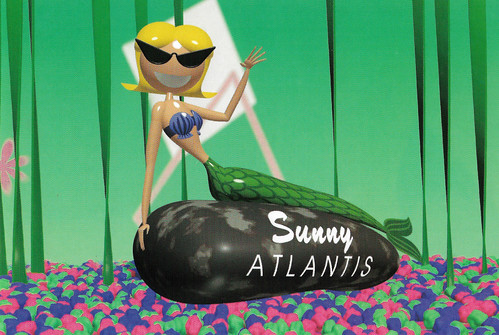
American postcard by Disney Enterprises / Pixar Animation Studios, 2005. Image: Pixar Animation Studios. Film image of Knick Knack (John Lasseter, 1989). From 'The Art of Pixar: 100 Collectible Postcards, published by Chronicle Books.
Boundin' (2003)

American postcard by Disney Enterprises / Pixar Animation Studios, 2005. Image: Pixar Animation Studios. Film image of Boundin' (Bud Luckey, Roger Gould, 2003). From 'The Art of Pixar: 100 Collectible Postcards, published by Chronicle Books.
Boundin' (Bud Luckey, Roger Gould, 2003) is a cute American computer-animated short film, which was shown in theaters before the feature-length superhero film The Incredibles (Brad Bird, 2004). In this musically narrated story, a dancing lamb loses his confidence along with his ability to dance after his wool is sheared off. Boundin's running time is 4:40 minutes. Writer-director Bud Luckey designed and voiced all the characters, composed the music, and wrote the story. At Pixar, he had worked on every feature film to date and is credited with designing Woody and other characters for Toy Story (John Lasseter, 1995).
According to the director's commentary for The Incredibles, Brad Bird wanted to introduce the animated short by having Rick Dicker, (the superhero relocator from The Incredibles, also voiced by Luckey) enter a room, sit down, and pull out a bottle of "booze" and a banjo. This is the first Pixar short with a theatrical release that has spoken words, they are in rhymes as well. All prior films included only music and sound effects although Bobby McFerrin did an acapella song for Knick Knack. Boundin' was nominated for the Best Animated Short Oscar but lost out to the Australian clay animation Harvey Krumpet (Adam Elliot, 2003).
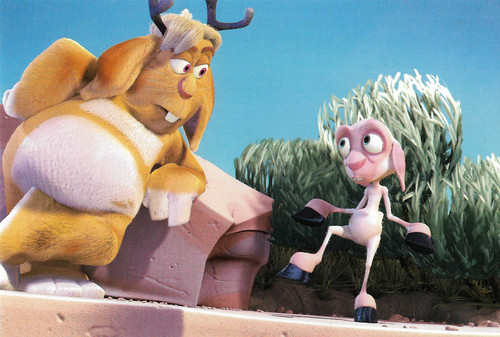
American postcard by Disney Enterprises / Pixar Animation Studios, 2005. Image: Pixar Animation Studios. Film image of Boundin' (Bud Luckey, Roger Gould, 2003). From 'The Art of Pixar: 100 Collectible Postcards, published by Chronicle Books.
Sources: (a.o.) The Big Cartoon Database, Wikipedia (Dutch and English), and IMDb.
No comments:
Post a Comment